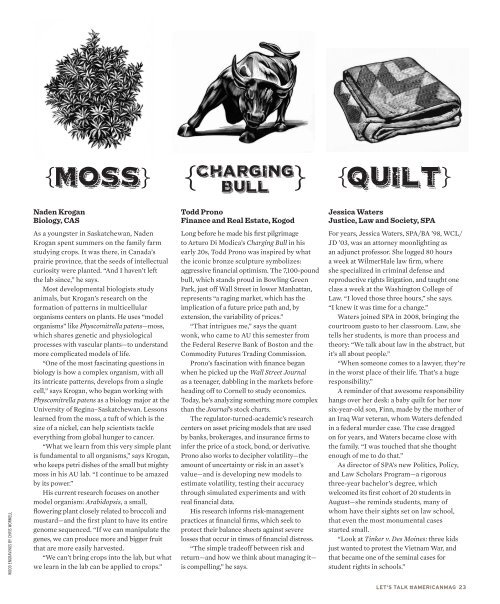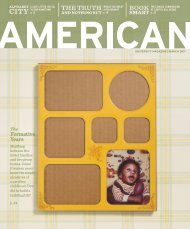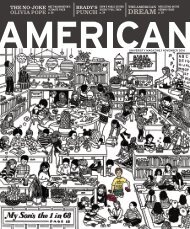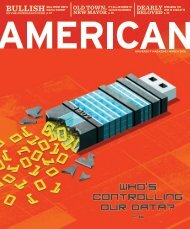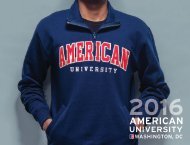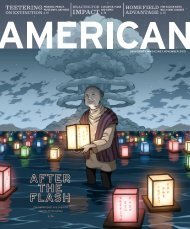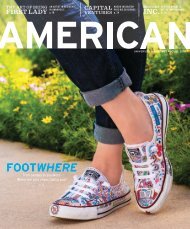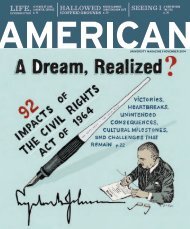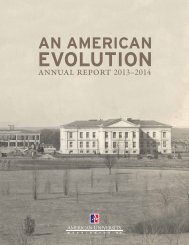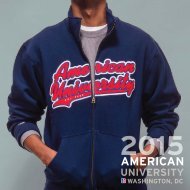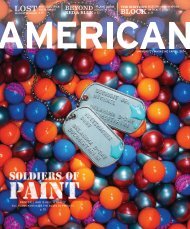You also want an ePaper? Increase the reach of your titles
YUMPU automatically turns print PDFs into web optimized ePapers that Google loves.
Naden Krogan<br />
Biology, CAS<br />
Todd Prono<br />
Finance and Real Estate, Kogod<br />
Jessica Waters<br />
Justice, Law and Society, SPA<br />
WOOD ENGRAVINGS BY CHRIS WORMELL<br />
As a youngster in Saskatchewan, Naden<br />
Krogan spent summers on the family farm<br />
studying crops. It was there, in Canada’s<br />
prairie province, that the seeds of intellectual<br />
curiosity were planted. “And I haven’t left<br />
the lab since,” he says.<br />
Most developmental biologists study<br />
animals, but Krogan’s research on the<br />
formation of patterns in multicellular<br />
organisms centers on plants. He uses “model<br />
organisms” like Physcomitrella patens—moss,<br />
which shares genetic and physiological<br />
processes with vascular plants—to understand<br />
more complicated models of life.<br />
“One of the most fascinating questions in<br />
biology is how a complex organism, with all<br />
its intricate patterns, develops from a single<br />
cell,” says Krogan, who began working with<br />
Physcomitrella patens as a biology major at the<br />
University of Regina–Saskatchewan. Lessons<br />
learned from the moss, a tuft of which is the<br />
size of a nickel, can help scientists tackle<br />
everything from global hunger to cancer.<br />
“What we learn from this very simple plant<br />
is fundamental to all organisms,” says Krogan,<br />
who keeps petri dishes of the small but mighty<br />
moss in his AU lab. “I continue to be amazed<br />
by its power.”<br />
His current research focuses on another<br />
model organism: Arabidopsis, a small,<br />
flowering plant closely related to broccoli and<br />
mustard—and the first plant to have its entire<br />
genome sequenced. “If we can manipulate the<br />
genes, we can produce more and bigger fruit<br />
that are more easily harvested.<br />
“We can’t bring crops into the lab, but what<br />
we learn in the lab can be applied to crops.”<br />
Long before he made his first pilgrimage<br />
to Arturo Di Modica’s Charging Bull in his<br />
early 20s, Todd Prono was inspired by what<br />
the iconic bronze sculpture symbolizes:<br />
aggressive financial optimism. The 7,100-pound<br />
bull, which stands proud in Bowling Green<br />
Park, just off Wall Street in lower Manhattan,<br />
represents “a raging market, which has the<br />
implication of a future price path and, by<br />
extension, the variability of prices.”<br />
“That intrigues me,” says the quant<br />
wonk, who came to AU this semester from<br />
the Federal Reserve Bank of Boston and the<br />
Commodity Futures Trading Commission.<br />
Prono’s fascination with finance began<br />
when he picked up the Wall Street Journal<br />
as a teenager, dabbling in the markets before<br />
heading off to Cornell to study economics.<br />
Today, he’s analyzing something more complex<br />
than the Journal’s stock charts.<br />
The regulator-turned-academic’s research<br />
centers on asset pricing models that are used<br />
by banks, brokerages, and insurance firms to<br />
infer the price of a stock, bond, or derivative.<br />
Prono also works to decipher volatility—the<br />
amount of uncertainty or risk in an asset’s<br />
value—and is developing new models to<br />
estimate volatility, testing their accuracy<br />
through simulated experiments and with<br />
real financial data.<br />
His research informs risk-management<br />
practices at financial firms, which seek to<br />
protect their balance sheets against severe<br />
losses that occur in times of financial distress.<br />
“The simple tradeoff between risk and<br />
return—and how we think about managing it—<br />
is compelling,” he says.<br />
For years, Jessica Waters, SPA/BA ’98, WCL/<br />
JD ’03, was an attorney moonlighting as<br />
an adjunct professor. She logged 80 hours<br />
a week at WilmerHale law firm, where<br />
she specialized in criminal defense and<br />
reproductive rights litigation, and taught one<br />
class a week at the Washington College of<br />
Law. “I loved those three hours,” she says.<br />
“I knew it was time for a change.”<br />
Waters joined SPA in 2008, bringing the<br />
courtroom gusto to her classroom. Law, she<br />
tells her students, is more than process and<br />
theory: “We talk about law in the abstract, but<br />
it’s all about people.”<br />
“When someone comes to a lawyer, they’re<br />
in the worst place of their life. That’s a huge<br />
responsibility.”<br />
A reminder of that awesome responsibility<br />
hangs over her desk: a baby quilt for her now<br />
six-year-old son, Finn, made by the mother of<br />
an Iraq War veteran, whom Waters defended<br />
in a federal murder case. The case dragged<br />
on for years, and Waters became close with<br />
the family. “I was touched that she thought<br />
enough of me to do that.”<br />
As director of SPA’s new Politics, Policy,<br />
and Law Scholars Program—a rigorous<br />
three-year bachelor’s degree, which<br />
welcomed its first cohort of 20 students in<br />
August—she reminds students, many of<br />
whom have their sights set on law school,<br />
that even the most monumental cases<br />
started small.<br />
“Look at Tinker v. Des Moines: three kids<br />
just wanted to protest the Vietnam War, and<br />
that became one of the seminal cases for<br />
student rights in schools.”<br />
LET’S TALK #AMERICANMAG 23


